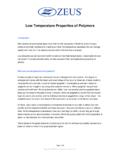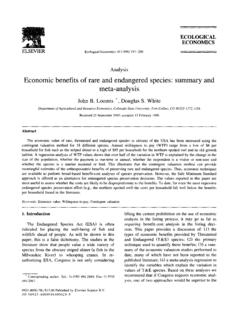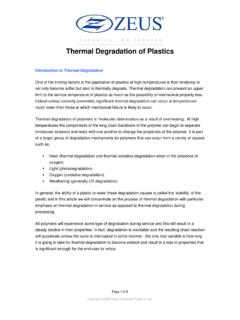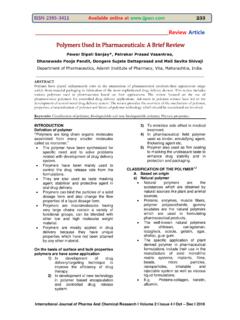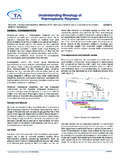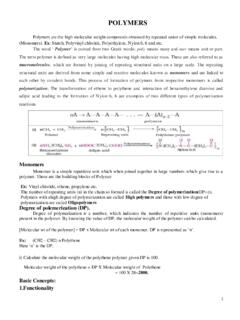Transcription of Flammability of Polymers - Appalachian State University
1 T E C H N I C A L W H I T E P A P E R. Flammability of Polymers Introduction Most plastics are carbon-based materials and will burn and give off gases and smoke when subjected to a flame. Plastics are excellent fuels but are generally classed as ordinary combustibles and fall into the same category as wood, leather and many other common materials. All of these materials will degrade at very high temperatures into volatile and gaseous combustion products. The Fire Triangle For combustion to take place three components are necessary and these form the fire triangle', removing any Ignition one of the components will prevent or extinguish a fire. Source Fuel The components are: (Heat). Fuel: There must be a source of fuel for any fire to take place. In most cases the fuel does not itself burn (except if it is a gas) but breaks down under the influence of the Air applied or generated heat to produce combustible volatiles (Oxygen).
2 That are then burnt. This is important in terms of how some materials may initially ignite but then form a char layer'. The Fire Triangle that prevents the formation of further gases and further combustion. Oxygen: This is a basic component of combustion. Ignition source: The ignition source is needed to heat up the fuel sufficiently to generate volatiles and then to ignite them. In the case of a gas the ignition source can act directly on the gas. Page 1 of 6. Copyright 2005 Zeus Industrial Products, Inc. The Combustion Process For plastics, the actual process of combustion is very complex but broadly follows 6 separate stages: Primary Thermal: The ignition source heats the bulk plastic to create a rise in temperature that depends on the product and the ignition source energy output.
3 Primary Chemical: The heated plastic starts to degrade, generally through the formation of free radicals, under the influence of the ignition source. This is similar to the conventional thermal degradation of plastics discussed in earlier newsletters but is generally more rapid because of a higher energy input from the ignition source. polymer Decomposition: The plastic starts to rapidly degrade into a range of lower molecular weight decomposition products. Typical products at this stage are combustible gases and liquids, charred solids and possibly smoke. Ignition: The combustible gases, in the presence of sufficient oxygen and the ignition source, ignite to start combustion. As noted above it is the combustible gases and liquids that burn and not the bulk material.
4 Combustion: The burning gases produce combustion at or near the surface of the bulk plastic and the process can become self- sustaining if it produces sufficient energy. Flame propagation: Depending on the plastic, the combustion stage produces flames (which can propagate), charred surface layers and can be accompanied by the emission of smoke and toxic gases. The response of plastics in the combustion process also depends on the type of plastic. Thermoplastics tend to soften and flow at high temperatures, often before ignition takes place whereas thermosetting materials do not soften but undergo localized surface charring (sometimes with flaming) and the charred residue can either fall off or remain in place to form an insulating layer. Page 2 of 6. Copyright 2005 Zeus Industrial Products, Inc.
5 Testing for Flammability As with any testing, the tests for Flammability are designed for the laboratory and quality control. In real fires plastics may behave significantly differently and the results of laboratory testing cannot predict the actual performance of a particular plastic or product. Burning Behavior Limiting Oxygen Index (LOI). The limiting oxygen index is a measure of the percentage of Limiting Oxygen Index oxygen that has to be present to support combustion of the plastic Material LOI. - the higher the LOI the lower the Flammability . Air contains POM 15. approximately 21% oxygen and therefore any material with an LOI. PMMA 17. of less than 21 will probably support burning in an open-air situation. PP 17. PE 17. In the LOI test, a candle like sample is supported in a vertical PS 18.
6 Glass column and a slow stream of oxygen/nitrogen mix is fed into PC 26. the glass column. The sample is ignited with a flame and burns PVC 45. downward into unheated material. The oxygen/nitrogen ratio can PTFE >95. be varied and the test records the minimum concentration of oxygen (as a percentage) that will just support combustion. The results for the test will vary considerably with the composition of the specific plastic being tested. The LOI value is a basic property of the plastic but tells us nothing about how the plastic will react to burning in an open atmosphere. Underwriters Laboratory (UL94). UL testing is a method of classifying a material's tendency to either extinguish or spread a flame once it has been ignited and although originally developed by UL, it has now been incorporated into many National and International Standards (ISO 9772 and 9773).
7 The testing involves applying a flame to a sample in various orientations and assessing the response of the material after the flame is removed. Materials that burn slowly or self- extinguish and do not drip flaming material will rank highest in the UL classification scheme. Page 3 of 6. Copyright 2005 Zeus Industrial Products, Inc. Horizontal Burning Test (94HB). This is the easiest test to pass and materials that pass the vertical burning test will usually be acceptable for applications that require a HB rating only. The test involves applying a flame to one end of a horizontal bar of the plastic for 30 seconds or until the flame front reaches the specified mark. If burning continues then the time taken to reach the second mark is measured. If burning stops then the time of burning and the damaged length are measured.
8 A material will be classified 94HB if the time taken to reach the second mark is greater than the specified minimum or if burning stops before the second mark. Vertical Burning Test (94V). This is a more demanding test than the HB test because the specimen is tested in the vertical orientation and the material burning at the lower end of the sample preheats the material in the upper areas of the specimen. A test flame is applied to the lower end of the test specimen and the material is classified according to the table below. UL94V requires materials to be self-extinguishing to pass the test. UL94-V Rating Duration of flaming Total duration of Dripping of flaming for each flame flaming for 5 samples material application (10 flame applications). V-O (Best) Less than 10 sec Less than 50 sec None allowed V-1 (Good) Less than 30 sec Less than 250 sec None allowed V-2 (Drips) Less than 30 sec Less than 250 sec Any dripping of flaming material which ignites the cotton placed below the specimen Page 4 of 6.
9 Copyright 2005 Zeus Industrial Products, Inc. Other UL Tests (94 VTM, 94-5V, 94 HBF and radiant panel). UL94 contains a range of tests for a variety if materials and scenarios such as 94 VTM for thin materials and surface burning but these are less commonly used than the 94HB and 94V test methods. Testing for Gases and Smoke Toxic Gases Toxic gases are the main source of death in many fires where high fuel loads of plastics are involved. Despite this there is no recognized standard for toxic gas emission testing. This is because the amounts and types of toxic gases generated depends not only on the plastics involved but also on the additives used in the plastics and the details of the particular fire. For most conventional plastics the main gas risk is the generation of CO, which at high concentrations is extremely toxic.
10 Smoke When most plastics burn, they give off smoke and this can be a major hazard in real fires. One of the most widely used laboratory-scale techniques to quantify the smoke generation from burning materials is the Smoke Box test developed by the National Bureau of Standards (NBS). This test measures the amount of smoke produced per unit area when a material is exposed to both flaming and radiant heat sources. The optical density of the smoke generated is measured as the smoke accumulates in a closed chamber system and test specimens can be burned in either the flaming or non-flaming (smoldering) mode. Flame Retardants Flame retardants can be added to most conventional plastics to improve the ignition or burning performance. The disadvantage of the use of flame retardants is that many of the more common additives can also increase the amount of smoke generated during burning.
